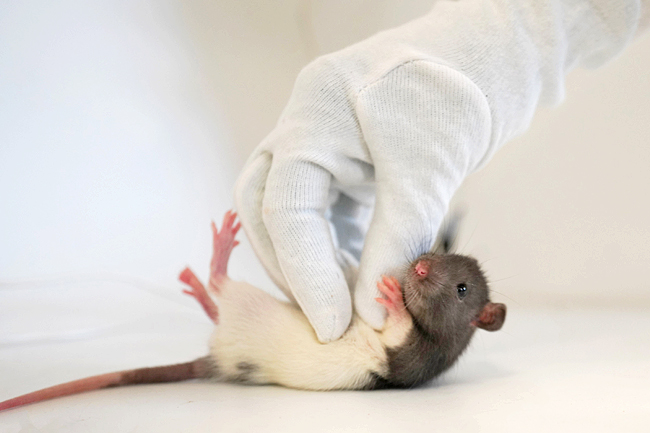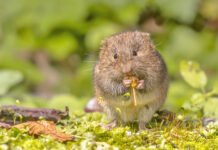THE WASHINGTON POST – Play during both childhood and adulthood is important for the healthy functioning of humans and other species, but why we play – the brain circuitry behind this behaviour – is poorly understood.
A new study in Neuron has identified groups of cells in the rat brain that may provide clues to the brain structures and their connections that are essential for play.
Understanding the neurological basis of positive behaviours such as play “may assist in developing targeted interventions to help people, especially children, struggling with the absence or dysregulation of such states due to underlying medical conditions or environmental circumstances,” said graduate student Natalie Gloveli at the Bernstein Center for Computational Neuroscience Berlin and lead author of the study.
The work also confirms that play is deeply ingrained in the brain, “reinforcing the potential value of play being used therapeutically,” said behavioural neuroscientist Sergio Pellis at the University of Lethbridge in Alberta, Canada, who was not involved in the study.
Researchers have used different words to describe play. It can be active, intrinsic, meaningful and voluntary, but it can also include rules and negotiation.
Play can take different forms, some social and others more solitary. Rough-and-tumble play between children or pets is an example of social play whereas some card games, kicking around a soccer ball and painting are examples of solo play.

A childhood filled with play has been closely tied to healthy brain development as well as better social-emotional and cognitive skills. Play in adulthood also has a range of benefits, including stress relief and increased creativity.
Without play, “you don’t have the same optimism, resiliency and well being”, said psychiatrist Stuart Brown, who began researching the importance of human play nearly 60 years ago, who was not involved in the study.
Playful behaviour occurs in several animals, Pellis said. “It’s very common in mammals, not quite as common in birds, and then you see it sporadically in other vertebrates, and then occasionally in various invertebrates,” he said.
Octopuses will play with objects in their environment and bumblebees with balls. There is “rough-and-tumble play in wasps and social spiders”, Pellis said.
There are several reasons humans and other species play, including that play may be important for the development of executive functions such as emotional control, awareness and response inhibition.
A lack of play, in contrast, has been linked to dire consequences.
Brown and others investigated why a 25-year-old man opened fire from the University of Texas clock tower observation deck in Austin and killed and injured dozens of people in 1966. They uncovered several possible contributing factors, including a childhood controlled by a “sadistic and somewhat cruel father”, which suppressed the shooter’s “natural tendency to play”, Brown said.
The investigation sparked Brown’s fascination with play. He soon received a grant to study certain inmates in Texas and learned that, similar to the shooter, the absence of play as children was a significant factor preceding homicide.
“None of the murderers I studied engaged in what I would call normal rough-and-tumble play,” Brown said. “And rough-and-tumble play and the ability to deal with hostility and still get along with your friends is a fundamental part of both animal and human experience.”
As a clinician, Brown continued to collect data on play from his patients and the patients of his colleagues, and grew increasingly convinced of its importance. He founded the National Institute for Play in 1996, a non-profit “dedicated to advancing society’s understanding and application of play”.
Brown, who a few years before had left clinical psychiatric work and begun studying play in other animals as well, saw the institute as an opportunity to break down academic silos between researchers studying play in humans versus other animals and foster the sharing of information.
Rats play, even when their cortex is removed. The cortex is a large area of the brain important for processes such as memory and language.
That motivated Gloveli and her colleagues to explore a deeper region of the brain called the periaqueductal grey (PAG), a structure involved in instinctive behaviours such as pain perception and defense.
“We assumed that play is also something that is quite instinctive,” Gloveli said.
The PAG is also involved in vocalisations – an important aspect of play. “Because play fighting can look like a form of actual fighting, it’s important to have vocalisations,” Gloveli said. “It’s a way of communicating, ‘we’re all on the same page’.”
Rats enjoy play and being tickled by the researchers who study them. “They’re vocalising a lot during the tickling,” the rat version of laughter, Gloveli said. “And they jump around when they’re being tickled. They look for your hand, they chase your hand.”
The researchers tickled rats on their backs and bellies, and had them chase after a researcher’s gloved hand. During play, they monitored rat vocalisations to ensure that the rats were having fun.
The team recorded neural activity from the PAG of young, playful rats and found a significant increase in cell activity during tickling and play. To confirm the importance of the PAG, they used drugs that block PAG activity. With the PAG blocked, rat play decreased, as did their response to being tickled.
Next, the team homed in on distinct regions of cells within the PAG that were more active during play and tickling and showed that blocking activity in those cells interfered with ticklishness and play.
They also showed that, under stressful conditions where the rat was no longer playing or vocalising, cell activity decreased.
“The really surprising thing about this paper is that the PAG is not only involved in producing the behaviour that’s used in play, but it actually seems to be involved in the motivation to engage in play,” Pellis said.
Data showed that the PAG is involved in interactions between species – humans and rats – as well as in social play between rats, which suggests “that the PAG is important in regulating social play in general”, he said.
Gloveli hopes to look at the PAG in other animals and begin connecting the still elusive brain circuitry that underlies play.
If you’re looking to add more play into your life or the lives of others, Pellis and Brown have some suggestions:
– For kids, “Free play with peers is really important,” Pellis said – something that’s happening less and less. Ideally, all schools would provide time for students to play; if not, he said, caregivers should look for opportunities for kids to play.
“And going off and playing an organised sport is not the same as playing freely with your friends,” he said. With free play, “you have to negotiate: What are we going to play? How are we going to play? What are the rules we’re going to follow? What happens if one of us breaks the rules? So all these executive functions are engaging.”
– “With adults, I think allowing more space for playful banter is very important in the workplace, because that’s a way of being able to test the waters,” Pellis said.
– If you’re feeling stuck trying to figure out how to play more or what that would even look like, Brown said, consider, “What is it that gave you a sense of gleefulness when you were a child? What is it that now takes you out of the sense of time and gives you a better feeling about the world?” It’s not the same for everybody, he said, so find something that personally gives you a sense of freedom and joyfulness.



















































